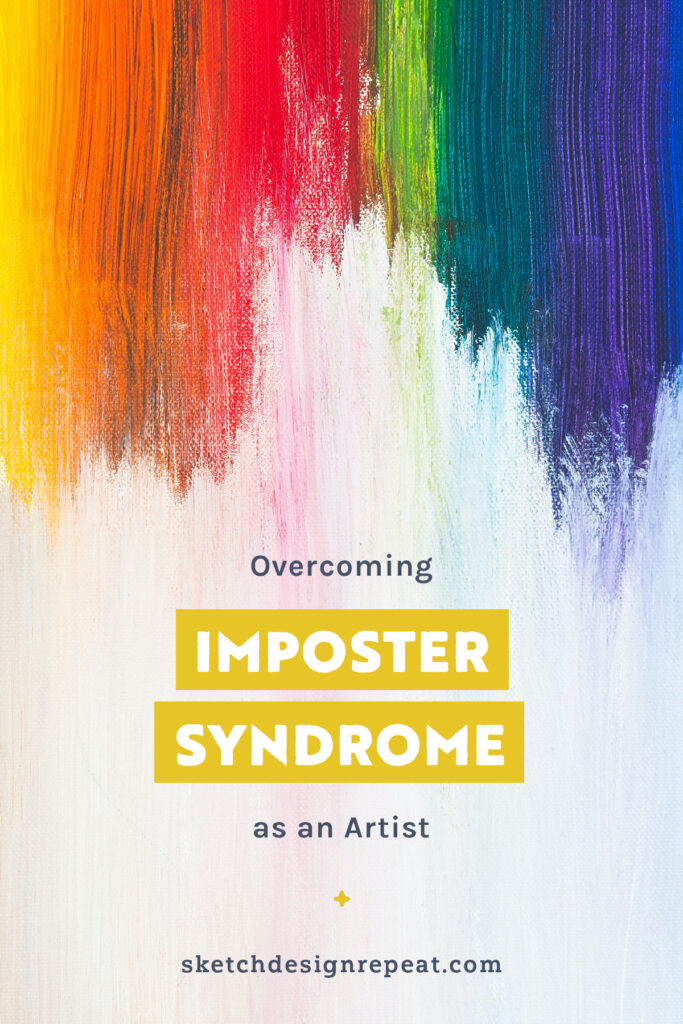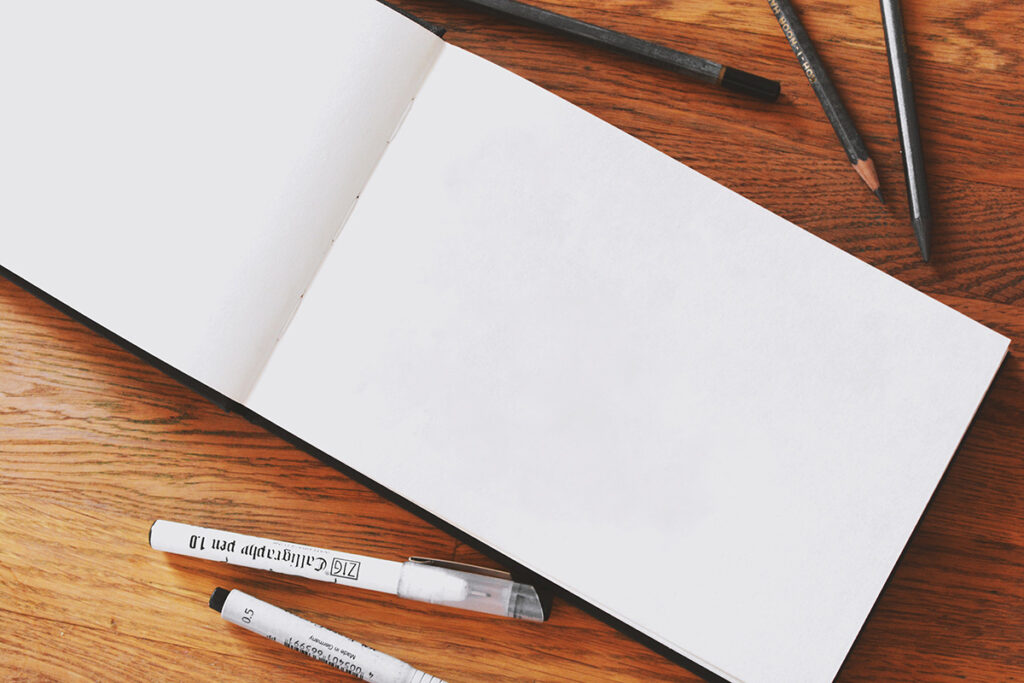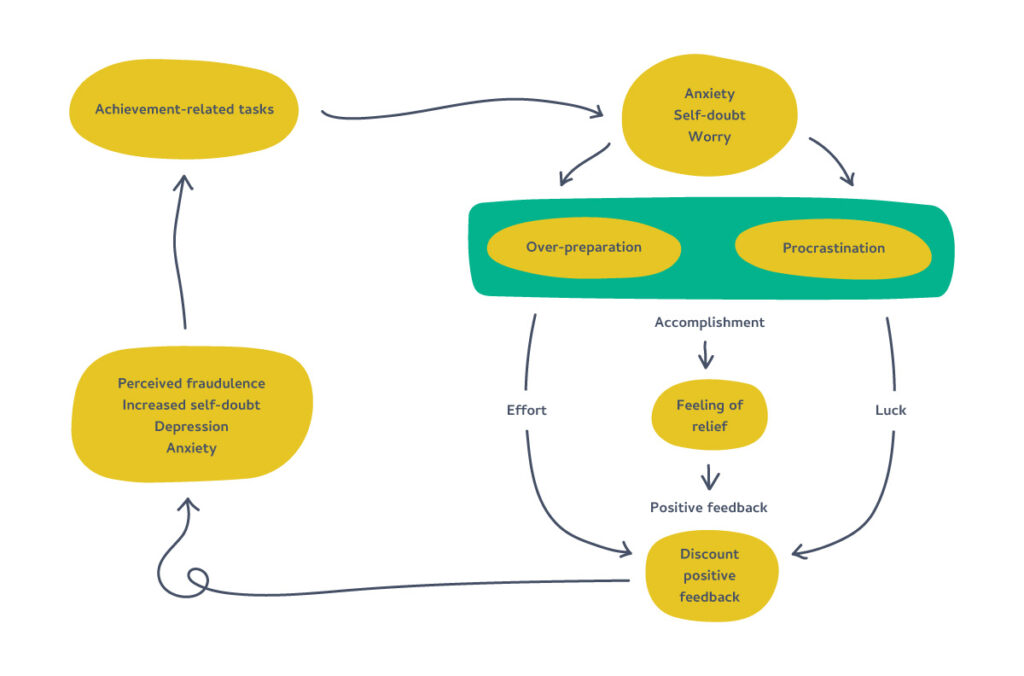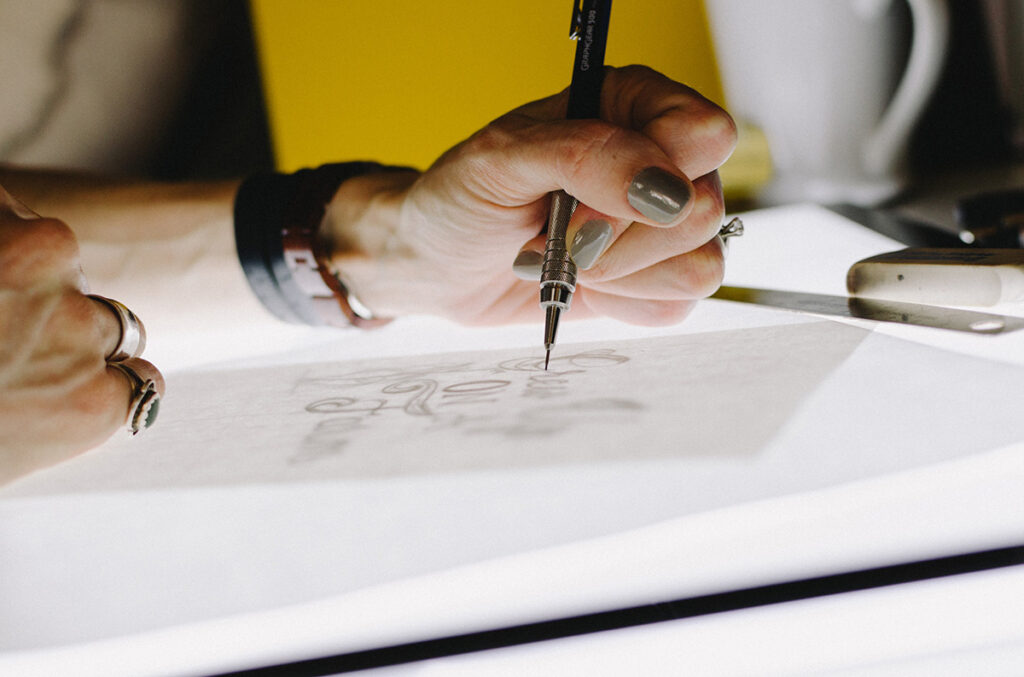For most of my career I’ve felt like I don’t know what I’m doing. I worry that I’m not good enough or deserving to call myself an artist. I often have to give myself pep talks or take on the “fake it ’til you make it” persona to push through my anxiety.
I also have a hard time remembering all of my achievements and will quickly move on to the next big goal without fully appreciating the gravity of my wins. I discount them and get overwhelmed by what is required of me to achieve the next goal because I’m afraid of making a mistake that will cause me to fail. I’ll procrastinate and tell myself that if I research enough, I’ll find the magic formula that will suddenly make everything better and easier.
Over time, I’ve come to realize that these are the characteristic feelings of imposter syndrome.

Imposter syndrome or imposter phenomenon is a concept that was first developed in the 1970s by psychologists Suzanna Imes and Pauline Rose Clance. Although it’s often called a syndrome, it isn’t a diagnosable mental illness. However, it’s widely acknowledged as a very definite form of intellectual self-doubt that can intensify negative feelings of insecurity and stress, often leading to anxiety and depression. It’s an internal belief that people generally don’t talk about it because they are afraid of being exposed as a phony.
Sound familiar? Symptoms of imposter syndrome as an artist
- Have an inability or hard time accepting compliments of your work
- Are easily and often overwhelmed with anxiety when working on art for fear of failing
- Have a lot of abandoned art pieces because you have a hard time finishing them if all conditions are not right at any part of the process of creating
- Discount your achievements and attribute them to luck or external factors
- Your artwork never seems to be finished because you often go back to tweak and perfect
- Don’t feel like you deserve to price your art so that it meets a living wage and undercut the value
- Feel out of place at professional events and networking opportunities
- Embarrassed when asked about what you do for a living and calling yourself an artist
- Extremely worried about what other people think about your work and the choices you make for your art business
- Constantly comparing yourself to other artists
- Feel like your work isn’t ever going to be good enough and being called out as a fraud
- Procrastinate or over-prepare for an art project

Why creatives are more vulnerable to imposter syndrome
It’s an incredibly common phenomenon. According to studies, an estimated 70% of people experience imposter syndrome at least one time in their lives. It’s an experience that transcends gender, race, ethnicity, class, religion, occupations, ability, sexual orientation, and cultures. It’s an especially prevalent experience among creatives.
“Being in any creative field makes you more susceptible to imposter feelings…the very nature of creative work makes everyone more vulnerable to feeling inadequate,” says internationally recognized imposter syndrome expert Dr. Valerie Young.
Artists are in a precarious situation because we are often encouraged to pull from our experiences when creating and to share our stories when explaining our work. The very act of sharing our work is a vulnerable state to put ourselves in, but is a critical part of building and sustaining a business around our art. It takes not only confidence but courage to put ourselves out there consistently. It can be difficult to navigate creative field standards and criticisms. Add social media into the mix and it’s easy to feel like you don’t match up or that you’re falling behind.
Worse, successes are often attributed to luck instead of one’s skills, qualifications, or intelligence and discounts any positive feedback. This creates a self-perpetuating cycle that prevents you from fully accepting any achievements.

The root of the problem
There are things you can do to overcome imposter syndrome. Research by Dr. Valerie Young has identified five types of imposter syndrome that each manifest in their own ways: the perfectionist, the expert, the soloist, the superhero, and the natural genius. Let’s dive in by examining which types you may experience to help in identifying the root cause.
1. The Perfectionist
Perfectionists set very high expectations on themselves and take it very hard if they don’t flawlessly accomplish what they set out to do. As a result, they rarely let themselves enjoy their successes. They can spend a lot of time planning how to best complete something to achieve their desired results or avoid trying new things altogether from fear of making a mistake or failing.
2. The Expert
Experts feel a lot of pressure to know everything about topics that are important to them. They often don’t feel ready or good enough if they perceive they don’t. They will spend large amounts of time researching and validating themselves through education and training, fearing they will be revealed as a fraud if they don’t know an answer.
3. The Soloist
Soloists place a lot of value in doing everything themselves and believe if they don’t that it means they are inadequate. Asking, needing, or receiving support or help is a sign that they have failed and highlights their self-doubt and perceived shortcomings.
4. The Natural Genius
The natural genius believes everything should be easy to master and that they should accomplish skills fast and with little effort. They get frustrated if they struggle to pick up a skill or subject and this affirms to them that they’re a fraud. They will avoid trying anything new if they don’t think they’ll be able to do it from the start for fear of shame and embarrassment.
5. The Superhero
Superheroes feel they need to be masterful in all aspects of their life. School, work, and relationships are all equally held up to their high standards. They constantly push themselves to work unrealistically hard, often leading to burnout. If they fail to meet any of these areas of their lives, they view themselves as a failure.
Related Article: How to Stop Comparing Yourself
to Other Artists on Instagram
Stereotypes, bias, and the stories we create
It should be noted that early studies of the phenomenon didn’t account for racism, classism, gender, or other biases. Biases are deep-rooted and based on previous experiences and current cultural and societal attitudes. They impact our perceptions and how we innately interact with society, our interpersonal communications, behavior, and decision making. Whether implicit or explicit, biases can foster internalized stories that can cause a disconnect between accomplishments and negative beliefs of inferior capabilities.
Recent studies show that underrepresented populations, particularly people of color, women, and those in the LGBTQ+ community are more likely to experience and develop imposter feelings. This suggests that the imposter phenomenon is created by the environment around us through systems of oppression, lack of representation, discrimination, microaggressions, and biases. These studies also indicate that underrepresented individuals are more impacted by these feelings because of the way they are treated by others around them because of their identities.
Furthermore, marginalized groups that experience microaggressions may feel imposter syndrome more keenly since the experience of questions, comments, and actions that are targeting them focus on the same doubts and feelings of self worth that push imposter syndrome.
Because imposter feelings are often created by the environment around us through stereotypes, biases, and systems of oppression, it is important to recognize that it will take collective work to address the systemic problems that contribute to imposter syndrome and its impact on underrepresented and marginalized groups.

Overcoming imposter syndrome
- Recognize when you are having imposter syndrome feelings and acknowledge them. Self-awareness is so empowering because once you become aware of something, you can take action to address it. Try to pinpoint if you fall into any of the five types of imposters to identify your root causes.
- Thank your uncomfortable feelings. Yes, thank them! Your brain creates these feelings as a way of signaling you to stop. New and challenging things are an evolutionary throwback to danger.
- Take time to reflect on the feelings you are experiencing as they are happening. Ask yourself questions to get to the bottom of why you are feeling a certain way and reflect on what you want to feel instead. This reflection will help you over time to understand your thoughts and behaviors, separating feelings from facts.
- Reframe your thinking and experiences more positively. List-making is a great way to reframe your thinking. Some lists you can create are listing evidence that counters your limiting beliefs of feeling like a fraud or failure, keeping a list of your wins and successes, or a list of positive things people have said about you or your work.
- Talk and share with trusted mentors or art friends for support. Most artists experience imposter syndrome. Sharing your experience can help you recognize your feelings and share strategies to deal with them. It also gives others permission to do the same and provides comfort that you aren’t alone with your feelings.
- Recognize that no one is perfect. Everyone is a work in progress who struggles with self doubt and is trying to figure things out throughout their entire life. Getting comfortable with being wrong, and admitting when you are, builds resilience. Lean into a growth mindset of pushing outside your comfort zone.
- Remember that we are all at different points in our art journey. No one is a complete expert and there is always something new to learn or a new perspective to see. Comparing yourself to other artists will only lead to a downward spiral. Consider limiting your time on social media if you find it’s affecting you.
- Own yourself as an artist. There is no one exactly like you with your experiences or perspectives so there is no one who can create exactly like you.
The bottom line is that imposter syndrome is very real. However, these feelings are normal and pretty much everyone experiences them, especially artists. It doesn’t mean they have to control you. We all make choices every day in how we see ourselves. It took me years to finally call myself an artist, but now that I can without feeling embarrassed I’m starting to recognize how imposter feelings are creeping into other areas of my art business. I’m learning to embrace that I’ll always be working through these feelings.

Written by Cody Alice Moore
Website: www.codyalicemoore.com
Instagram: @codyalicemoore
Class: Client Feedback Strategies for Creatives
Cody is an artist, illustrator, and surface pattern designer with over 15 years of experience. Cody discovered surface design while working for four years as an art buyer for a national photo lab. Since 2019, she has been creating art full-time for her budding portfolio and growing collection of licensed designs.
Thank you Cody, Reading your article has given me fuel to work on my constant questioning of my pricing/time/material, worth. I find that among people I know who lovingly want to purchase my jewelry I become very shy and question the value of my work. I become fearful when I name the price for a piece and fill my own head with words like “my work is too high priced” or “how can I justify asking this amount”. My feedback however from buyers at shows or from local friends is always positive and complimentary. I must now write down these positive words so that I can see them everyday.
Anyways, thank you for your informative article, I am completely appreciative that you put your positivity out here for me to find. Wishing you all the best, Rachel.